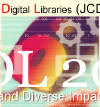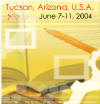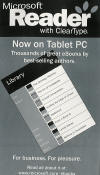Digital Libraries
and e-books
Digital Librairies


E-books


Digital
libraries is another trends in the publishing sector, however probably
the library as a physical place will never be replaces, still with the
use of the digital libraries the access worldwide by almost anyone is
achieved. [BENJAMIN 1994] [DAVIS 1997] [FARRINGTON 1999]]
[JONES 2000] The digital libraries are places
where the flow of information knowledge is everlasting since the access
to several specific digital libraries as well as electronic journals,
search engines are provided. In addition having in mind that in order
one be able to use these big amounts of information resources correctly,
a new areas are developed where the use of new techniques is teach in
order to achieve a better information resource practice. From common
practice and experience as information seeker using these information
resources such as search engines digital libraries or electronic
journals a certain technique are developed where the recognition of the
Boolean operators in the queries is essential when searching. Still
different features are offered in each and every of the medium, since
there are specialized searching tools providing the capability to search
for sounds, images or even
pdf
files. The key point of using these
information resources is following the correct search strategy that
leads to the desired result, information. The appearance of digital
libraries has closely affect the librarian sector and promote the
improvement of the services provided by the librarians to the users as
well as the librarians themselves in their everyday routing procedure in
there working environment.
top^
E-books can be easily interpreted from the
'e' that stands for 'electronic' and books that stands for the
well-known p-books.
E-books can be with or without added features, to
interactive fiction and non-fiction where the reader can choose a
personal route through a specific root or typesetting, dazzling effects,
disparate leaps of thought, and a fusion of image, word and animation.
All these are variant forms of
e-books
and well introduced to the
WWW,
on
CDs, on tablet and
handheld
pcs, or on dedicated e-readers. However
it is very interesting to have a quick review of
e-publishing history.
In the early 1990s the
electronic publishing
initiative start with
companies like Voyager and Vertigo Development that offered books on
CD-ROM for consumption on desktop computers [MAXWELL 2000].
Additionally organizations initiatives like
Bartleby.com and
Project
Gutenberg specialized in digitizing the text classics that had fallen
into the public domain had the unique idea of making them available for
downloading via Internet [O’LEARY 2000]. In the 1992 Sony Company promotes the
first dedicated “reader” the
Sony Bookman, widely known as “a brick with
screen” [Lardner, 1999]. With the rapid growth of the
World Wide Web by
the end of the 1990s things looked promising for e publishing and
products such as
NuovoMedia’s Rocket e-Book were released in 1998 and
quickly followed by
SoftBook Press’Softbook, the EveryBook, and
additional software that allowed the
downloading and reading of book
text on Palm and other personal digital assistants. Despite the fact
that several software were developed the number of readers was reducing
and in 1999 Microsoft Affiliated with a group of 75 publishers had the
idea of developing a technical open standard that would permit book
files to be read on multiple platforms-desktop computers, a variety of
portable, dedicated reading devices, and handheld computers [MAXWELL
2000]. In March 2000,
the Association of American Publishers
met to
consider the future of e publishing. These was viewpoint was based upon
a report from Andersen Consulting that suggested industry-wide adoption
of an open standard. The predictions were that number of reading devices
in the hands of consumers would increase from 30000 to 28 millions by
2005 [MILLIOT 2000]. Another initiative was promoted in March 2000 by the
most know writer of novels
Stephen King. His idea was to release an
e-published story “Riding the Billet. The results was that the site had
400.000 downloads in the first day it was online [CASTELLUCCIO 2000]. On
the other hand the things were not encouraging when King asked voluntary
pay $1 per chapter from the users. The expectations were that 75% of his
readers would voluntary pay however the result was that 50% of readers
compiled. Due this circumstances
Stephen King suspended the experiment [JANTZ,
2001]. A number of potentially major companies related with e publishing
in November and December of 2001 were out of business due to the
disappointing operating results, a vivid example was
Time Warner
that
announced plans to close
IPublish.com and
Mighty-Words.com announced
plans to close shop [REID, 2000]. Finally
Random house announced the end
of an e-publishing program that had begun less that a year earlier
[ROGERS & RONCEVIC 2002].
top^ |